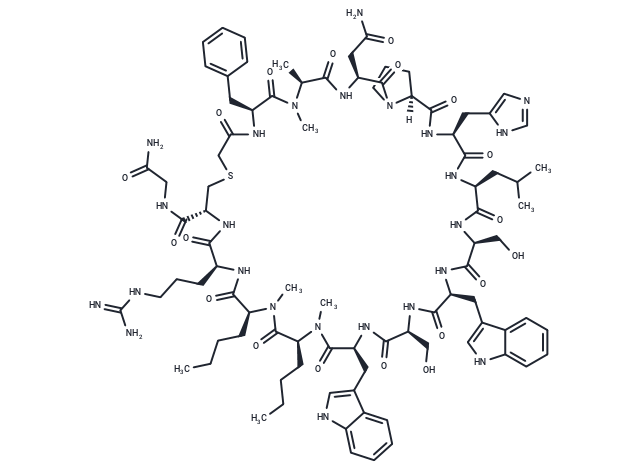Shopping Cart
Remove All Your shopping cart is currently empty
Your shopping cart is currently empty
BMSpep-57, a potent macrocyclic peptide inhibitor, competitively disrupts the PD-1/PD-L1 interaction, demonstrating a significant inhibitory concentration (IC50) of 7.68 nM. It exhibits binding affinity towards PD-L1 with dissociation constants (Kd) of 19 nM and 19.88 nM in MicroScale Thermophoresis (MST) and Surface Plasmon Resonance (SPR) assays, respectively. This compound enhances T cell functionality by promoting Interleukin-2 (IL-2) production within Peripheral Blood Mononuclear Cells (PBMCs).

| Pack Size | Price | USA Warehouse | Global Warehouse | Quantity |
|---|---|---|---|---|
| 25 mg | $1,520 | Inquiry | Inquiry |
| Description | BMSpep-57, a potent macrocyclic peptide inhibitor, competitively disrupts the PD-1/PD-L1 interaction, demonstrating a significant inhibitory concentration (IC50) of 7.68 nM. It exhibits binding affinity towards PD-L1 with dissociation constants (Kd) of 19 nM and 19.88 nM in MicroScale Thermophoresis (MST) and Surface Plasmon Resonance (SPR) assays, respectively. This compound enhances T cell functionality by promoting Interleukin-2 (IL-2) production within Peripheral Blood Mononuclear Cells (PBMCs). |
| Targets&IC50 | PD-1/PD-L1:7.68 nM (IC50) |
| In vitro | In an ELISA competition assay, BMSpep-57 inhibits PD-1/PD-L1 binding by up to 98.1% at 300 nM, with a concentration-dependent inhibition and an IC50 of 7.68 nM [1]. BMSpep-57 induces high levels of IL-2 at 1 μM and 500 nM in SEB-stimulated peripheral blood mononuclear cells [1]. BMSpep-57 (0.2-10 μM; 24 hours) does not affect the viability of Jurkat, CHO, and HepG2 cells at the tested concentrations [1]. |
| Molecular Weight | 1868.2 |
| Formula | C89H126N24O19S |
| Cas No. | 1629655-80-6 |
| Smiles | [H][C@@]12CCCN1C(=O)[C@H](CC(N)=O)NC(=O)[C@H](C)N(C)C(=O)[C@H](Cc1ccccc1)NC(=O)CSC[C@H](NC(=O)[C@H](CCCNC(N)=N)NC(=O)[C@H](CCCC)N(C)C(=O)[C@H](CCCC)N(C)C(=O)[C@H](Cc1c[nH]c3ccccc13)NC(=O)[C@H](CO)NC(=O)[C@H](Cc1c[nH]c3ccccc13)NC(=O)[C@H](CO)NC(=O)[C@H](CC(C)C)NC(=O)[C@H](Cc1cnc[nH]1)NC2=O)C(=O)NCC(N)=O |
| Sequence | {mercaptoacetic acid}-Phe-Ala-Asn-Pro-His-Leu-Ser-Trp-Ser-Trp-{norleucine}-{norleucine}-Arg-Cys-Gly (Sulfide bridge:mercaptoacetic acid 1-Cys15) |
| Sequence Short | {mercaptoacetic acid}-FANPHLSWSW-{norleucine}-{norleucine}-RCG (Sulfide bridge:mercaptoacetic acid 1-Cys15) |
| Storage | keep away from moisture | Powder: -20°C for 3 years | In solvent: -80°C for 1 year | Shipping with blue ice/Shipping at ambient temperature. |
| Size | Quantity | Unit Price | Amount | Operation |
|---|

Copyright © 2015-2026 TargetMol Chemicals Inc. All Rights Reserved.